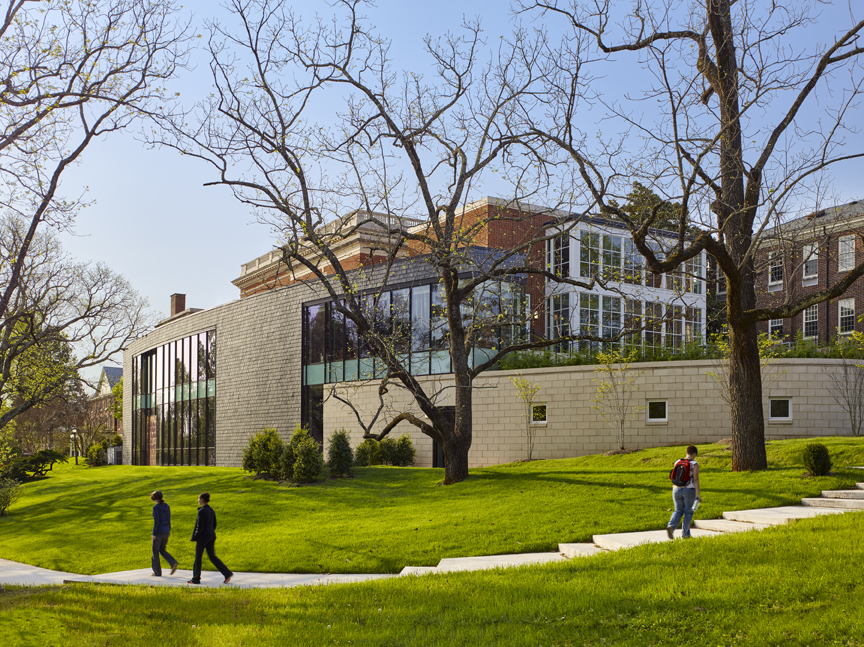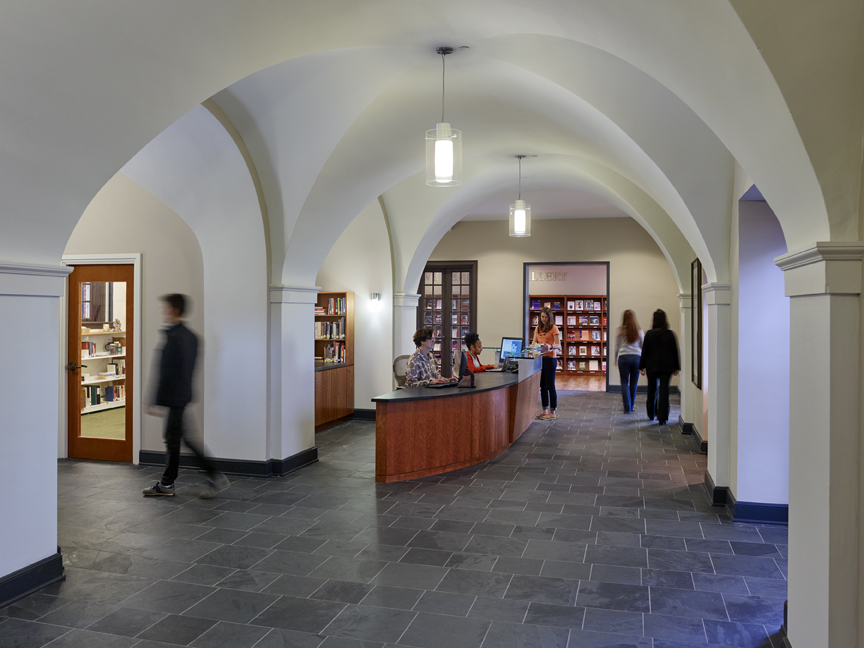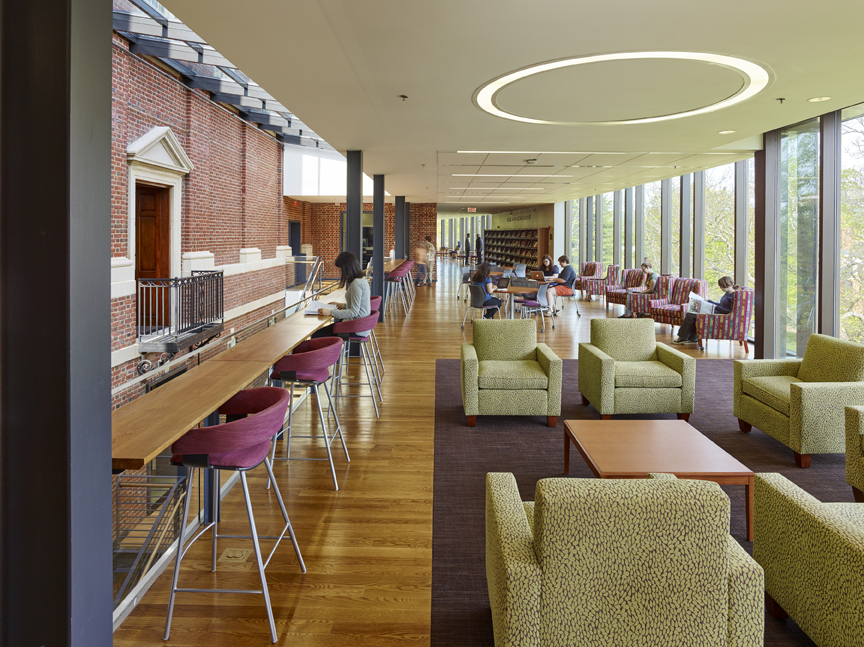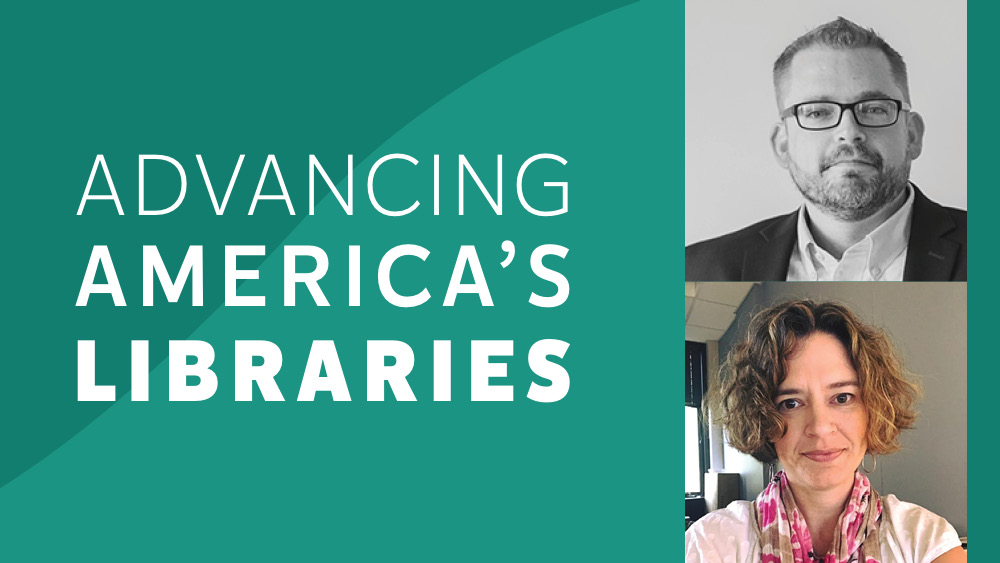The following is an informal transcription of this episode of the Advancing America’s Libraries Podcast.
Immediately, the services have to change because as we're walking through staffing and space implications, the space has to change for social distancing reasons and for staff health and safety protection.
Julie Kane
Pam: Colleges and universities are trying to figure out how they can open safely in the fall. At the epicenter of this discussion are those sites where students are known to come into close contact, e.g., dorms, gyms, bathrooms, dining halls, and, of course, libraries.
To discuss how one university library is managing this "new normal", we have Julie Kane (@juliekane99), Associate Professor and head of Collection Services at Washington and Lee University in Lexington, Virginia. Julie has held positions at Sweet Briar College, Stanford Law School, and Middlebury College. She is an active member of ALA. Her book reviews appear in Library Journal and she is a columnist with College and Undergraduate Libraries. Welcome, Julie!
Julie: Thanks so much. I'm excited to be here.
Pam: I'd also like to welcome back Jim Kovach (@JCK237), an architect at VMDO, a firm here in Charlottesville, Virginia. His work has included significant public and academic library projects, ALA presentations, and he has been a contributor to Library Journal. Jim co-founded the Charlottesville Community Design Center and has taught design studios at The University of Virginia, his alma mater. Welcome back, Jim!
Jim: So good to be back with you, Pam, and delighted to get to spend some time with my old friend, Julie Kane.
Pam: I understand you met at Sweet Briar College when VMDO was contracted to design an addition to the library there. Is that correct?
Jim: That's right. It was a great opportunity to work on a beautiful Ralph Adams Cram campus and their gorgeous library. I met some very talented librarians there.

Scrambling to adjust
Pam: I'm looking forward to a lively discussion today. Julie, you've been directly involved in the day-to-day operations since COVID-19 closed your library. I believe it was in March. Is that correct?
Julie: That is, yes.
Pam: I'm assuming you're in the center of discussions about re-opening in the fall. Can you talk about how closure unfolded and how you had to react at that time? And what kind of impacts we can expect to see in operations in the fall?
Julie: Sure! It's an interesting discussion, and it's kind of fun to talk about. When we're talking about re-opening, we're talking about re-opening the physical building, but, of course, we've been working nonstop since being sent home. We may be opening the physical building, but the services have been provided this entire time. But they just looked different.
When we went home, there was a scramble to figure out what we were doing and how we were going to provide services. Some people, of course, could not continue with their work as normal. There were a few staff members who were sent home and would not be continuing work because their work is rooted in the physical processing of materials. That is really hard to do and has been a difficult challenge for some who are used to coming into work every day and handling materials. To suddenly have no work at all to do is hard.
Pam: I'm assuming that processing materials at that point became impossible. Is that correct?

Steep learning curves behind and ahead
Julie: Absolutely! We immediately ceased touching anything. We immediately ceased ordering and handling print materials. We immediately ceased interlibrary loans across the state. For a library, that's tough! We switched immediately to all online operations. Of course, we have so many resources that are already online. A lot of our work was educating our faculty in what we have already in adapting their curriculum.
Our schedule is a little bit different than a lot of other universities and colleges in the area. We switched towards the end of our winter term, and then had another spring term to contend with, a four-week intensive term. We had a slight break in-between for professors to ramp up and redesign courses to be all online. But we had a sudden influx of requests for other online materials: a lot of streaming video content, a lot of eBooks. For example, as they were pivoting to redesign courses, could eBooks be substituted for print monographs? There were steep learning curves and a dramatic influx of requests for electronic materials.
At the same time, we have this crisis and budget crisis in tandem. We have one electronic resources librarian who is handling all of this. Bless her, she is working nonstop to handle these massive requests. There are many wonderful vendors who flooded the market with tons of free electronic resources either for a limited or extended period during the COVID-19 semester. Some are relevant or not, and some of them are free or not-so-free. We had to sift through all the offers.
Pam: Worth the price you were paying, right?
Julie: Exactly! Is this the hook to get us to pay once we're done? At the same time, we had to disseminate that information to our faculty. This was a challenge being handled on the fly, doing it with the budgetary crisis, and trying to cancel resources while we're buying resources. It was so much to handle at once.
I felt fortunate that we had a CFO who was on top of anticipating the cuts we would have to make almost immediately as they refunded room and board to students being sent home. "This is the hit we're going to take from those refunds. As long as students will be coming back in the fall, this is the cut your department will have to take." We could anticipate and make the cuts we needed to make to our collections. But we are anticipating a real increase in need for electronic resources to support the new reality.
It is a challenge to support electronic resources while we're cutting, while we're adding all at once, and while the frontline librarians are working just as hard switching to an online environment. They've instituted an online chat and reference service. Rather than showing up in courses and giving one-off instruction sessions, they are popping into courses online as well as Zoom sessions like this.
Pam: That's a big change. If there's an upside to all of this, there is increased use of electronic resources that historically have been totally unutilized.
Julie: I agree. Absolutely. It's a balancing act to find out which electronic resources we're using. We're making better use of our usage statistics and communicating more with our faculty. It's a learning experience all around to find out what we have and what we can let go.
It's a hard learning curve for the vendors as they would normally give us a lot of steep increases to our annual subscriptions.

The space implications of reopening
Pam: All this transition to greater reliance on electronic resources and staff reshuffling that must occur because of the new functions demanded by the situation have space implications. I'd like to move to those design issues because I know that you and Jim have worked together in the past on library design projects, first at Sweet Briar and now at Washington and Lee. Given your experience with these two institutions, how do you foresee academic library services changing in the future? Then let's talk a little about the space implications.
Julie: Immediately the services have to change because, as we're walking through staffing and space implications in planning to come back to work, the space has to change immediately for social distancing reasons and for staff health and safety protection.
One thing that has been on my mind, and I'm sure on the minds of directors everywhere, is that this changes the character of the building. The character of the building is really delineated by floor and by how social those floors are. That is immediately lost. We cannot have group gatherings. We must keep people apart, and the implications are huge. The services immediately change, too: contactless check-out, barriers at access points, staggered staffing with a lot more staff being remote for who knows how long. This changes the dynamic of the whole building. I'd be happy to know what Jim has to say about this.
Pam: It's ironic because libraries, in this day and age, are supposed to be the communal gathering place. This is actually counter to what we've been transitioning toward.
Jim: I totally agree with Julie's assessment about the increased presence of technology and the media services she is discussing, but I might turn this back to you, Julie, after I've shared this observation.
As libraries rely more on bookable spaces such as small group study rooms where you are able to distribute users and track how the building is getting used, I wonder if you worry as there are more self-service activities that some of your populations might start slipping through the cracks? In some of the reading I have been doing, first-generation students are typically most pleased with library spaces, but may be least satisfied with the services that the library provides? And I think that indicates a bit of a disconnect between their expectations and what libraries can provide. Just wondering if you have thoughts about how the different populations at your university might be impacted differently?
Julie: I agree with you. I think the less we are there physically, the more we lose that connection and the opportunity to engage with those students and to find out where we're losing them. This hurts us a lot. This is a problem that we must find more creative ways to workaround. Getting through the initial emergency and being able to maintain our fundamental services is the first hurdle. Then we need to get to all the communities and to find more creative ways to solve our bigger problem.
Jim: I heard an interesting analogy that if the space within the library is the hardware of the library, then it is the social norms surrounding the use of the library that is the software. It seems to me that you must align the hardware and the software or the space with these new norms to succeed with any new service model. I'm curious. It appears none of us have good answers yet as to what the landscape of the library looks like in the fall. Some measure of the responsibility is really going to fall upon the shoulders of the students who use the library to observe the measures we've put in place. The service model is reliant so much both on the spaces and how you as a librarian manage them but also how responsible and aware the student body is of just how important it is to follow these new norms to make sure the place is as safe as it can be.
Lots of challenges going forward. I'm so interested to see what it looks like in the fall. I'm assuming that you guys have decided you will open in the fall and have a schedule somewhat in place, right?
Moving access beyond the physical space
Julie: The plan is to be on campus, and we have a phased approach for at least getting staffing in place to welcome students back. All that is with a caveat—anything could change at any moment. Right now, we're working through Phase 1 of our staff returning to campus. We currently have a few staff members in the library. We're moving very gingerly and very slowly in reopening the physical building and even by the time we get to perhaps August 11th, which is the end of Phase 3, we will only be open to faculty by appointment. Then by the time the Law School opens which is before the undergraduates return, we will be open by swipe card access only. We're not planning to open the library to the broader community which we normally would be. We're playing it conservative and safe. Masks will be required in the building and keeping 6-feet distance among everyone.
There's so much planning going into keeping everyone as safe as possible. Not everything is fully set yet but we're doing the best we can and going as slowly as we can.
Pam: I think it was Rahm Emanuel who said, "You never want a serious crisis to go to waste." I'm wondering, to Jim's question, what are the longer-term implications for your space and your services?
Julie: That's a good question. I would be more worried if this only impacted libraries because, as you know, any time space goes unused on a campus, it's taken over. It's a land grab. But since this has shut down all spaces on campus, I don't worry about that as much. I do worry more about the flavor and character of it. If it's not going to be a hub on campus anymore or for an extended period of time, what does it become?
Jim: It seems to me that a big concern obviously is maintaining equity in access to the library and its services. Since so many students will be vying for fewer seats, I wonder if you feel the library will have to become a bigger partner across the university so that you're working with other programs to ensure that the whole community of learners can be accommodated? Essentially if you take the density of the library as it had been and you still have the same demand for the space, do you foresee a time at W&L where you're actually expanding the perimeter of the library beyond its walls so you're capitalizing on under-used academic space somewhere else or lounge space in student housing? It seems as if there is an opportunity to fragment that user space and allow it to move beyond the perimeter of the library. You could partner with other departments to manage space more holistically.
Julie: That's interesting. I've never heard anyone put it that way because the library is usually on the defensive about space. Libraries, in general, have never had that mindset of expanding beyond their own boundaries. That's super interesting and is hurting my brain as a concept. *laughter* We don't do that! I need to sleep on that and try to envision how that would work.
There are a lot of places on campus where students have "hidey holes" where they can study. I don't know that they have as many places where they are used to studying together as they have in the library. I think finding those group spaces would be harder but also not applicable perhaps in this environment. So, I'm not sure what we would be looking for.
The implications for collection size
Jim: There's another aspect to it. Pam, you and I discussed a couple of weeks ago the idea that in public libraries there is some discussion about attempts to densify the collection or reduce the footprint of the collection in the building so there is additional space for users. I want to ask Julie if she felt that likelihood was equally strong in academic libraries whether that means additional compact storage or offsite storage to free up square footage within the library for more seats at a greater distance from one another.
Julie: I think if academic libraries have not already done so it is a good idea to think about. The problem is going to be the budget. Schools won't be looking for places to spend money. I'm relieved that we did just put in compact shelving so we are freeing up some space, but I'm not sure they will look to see that student space in libraries is that high of a priority.
Pam: You talked a lot about technology changing the way people more and more access information. Think about Zoom conferencing or some of the online distance learning technologies that are available. Can the academic library perhaps take its lead from public libraries that are looking toward remote locations or remote services? You become less the source of the information and more of the facilitator for information sharing. Is that something you see in your future? It doesn't seem to me that it would cost a lot more—just a reallocation of resources. For example, to access resources such as the ILS students can go online. Often, they are on mobile devices which are not easy ways of communicating with people on Zoom, for example. Is it possible that the library could move some its terminals elsewhere on campus and provide the same level of service that it does in the library? But in a way that enables group meetings, for example? People don't have to be in the same space, but they have the technology available to them to share as they did in the past.
Julie: Any of the electronic resources we provide are available to students and faculty regardless of device. They don't need to be tied to a machine in the library to use them. That's why teaching remotely and learning remotely has been fine. They can just log in to their W&L account and access anything so that's not been a problem. That's more of an issue for community users who cannot access our resources unless they are in the building.
Remote room booking
Jim: Regarding technology in academic libraries, I want to hear both of your thoughts about something I have been hearing a lot more about. That is the ability to provide bookable spaces for students as they begin to return. Julie, I've seen the great group study spaces that you have. A lot of universities are beginning to turn toward digital room signage panels that allow people to reserve spaces either in person in the library or remotely on your device. I also wonder if more universities will begin to turn toward this technology to track students. Do those devices enhance our ability to understand who's in what space and with whom? If there is a minor outbreak on campus, there is a tool available to get a better understanding of who might be exposed to a carrier.
Julie: That's interesting. I haven't been part of any discussion about the room booking system. We do have them in place, but I haven't heard about it for contact tracing as such. I know that part of our back-to-work process involves logging all our contacts every day. That is part of a requirement for all staff heading back to work. There are not many details yet on what the structure is. I don't know if there are similar requirements for the students. Since the room booking system is in place, I can see how it could be tapped to use for contact tracking.
Pam: Listening to all of this, Jim, how is this going to change what you do?
Jim: That is such a good question, Pam. If you could point me in the direction of a new client, I'd gladly answer that question alongside them. *laughter*
I think it will be challenging to understand what we all mean by distancing and the guidelines going forward. There are so many different takes on it. Unfortunately, it's a little bit squishy.
Are we talking about a 6-foot diameter safe zone? Are we 6 feet apart? FEMA has outlined that 113 sq. ft. per seat is the ideal allotment for each user which is a little bit more than a 10 ft X 10 ft box. The understanding of that type of data is going to be so important to how space is laid out and how building programs get established. I think we need more clarity. Encourage your listeners to find the AIA's Reoccupancy Assessment Tool online. There are some good hints in there for smart ways to move forward regarding libraries and any academic space. VMDO is going to be working closely with the AIA to ratify smarter ways forward regarding space planning.
You and I talked about some short-term spatial adjustments that will need to occur. Those may be last week's news, but they are some basic things to add to the discussion such as sneeze guards, motion sensors in restrooms, hands-free water fountains. I honestly think a movement we will see is away from large group spaces such as auditoria, theaters, large lecture rooms towards re-capitalizing those spaces as clusters of smaller spaces that would accommodate 2-5 people as opposed to 30. The dynamic will shift from large gatherings to more intimate settings.
To Julie's earlier concerns, I, too, am concerned about what the library will look like in 5 years, but I also think this is a good opportunity to study how to make it the most welcoming building on campus–whether that is design details and furniture or the relationship of spaces and connection to campus. I'm excited to work with Julie and others to envision what it will all look like.
Pam: Thank you, Jim and Julie! This has been very interesting. Obviously, there are more questions than there are answers. That's because the times are changing quickly. There are so many budgetary implications as you mentioned, Julie. The human dimension of this is significant. The fact is we are social creatures, and learning is not an isolated experience. It is interactive and more productive when it is. In the short term, you're prepared!
Thank you for joining me today! Let's continue these conversations.

Thank you for listening to another episode of the Advancing America's Libraries Podcast. If you have any topic requests, tweet us @IvyGroup or email contact@ivygroup.com.
Category: Libraries
Tags: facilities, libraries, podcast